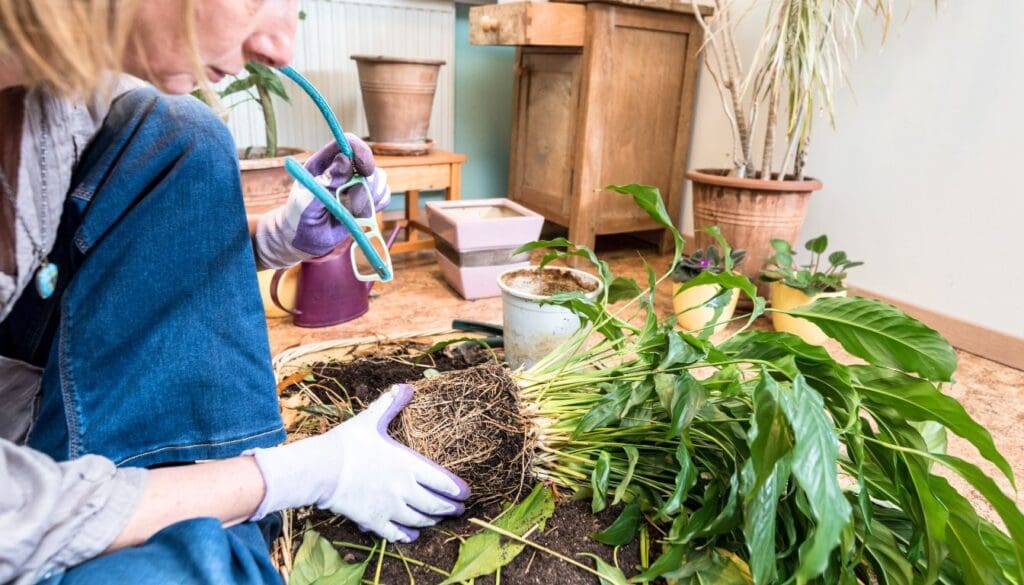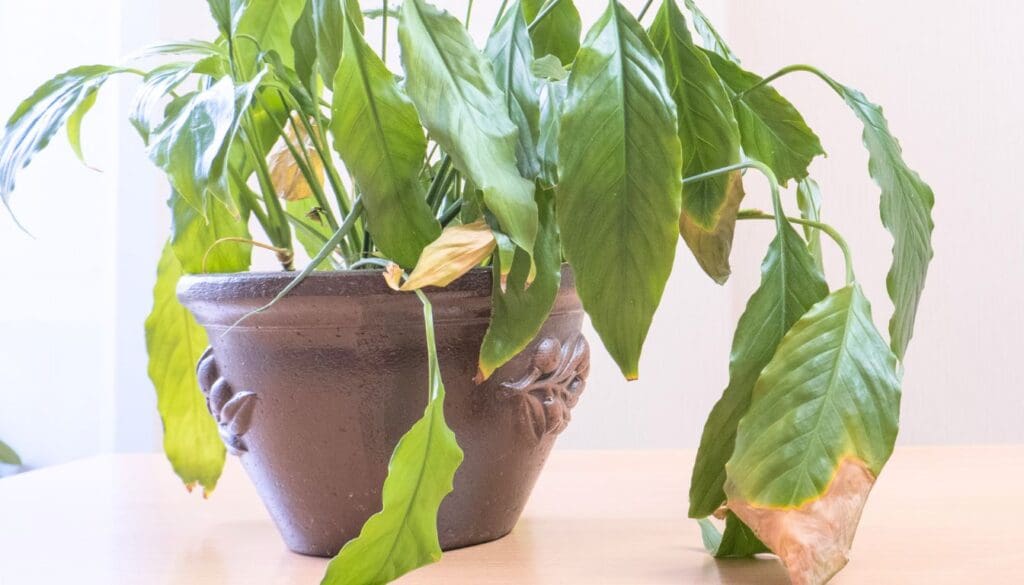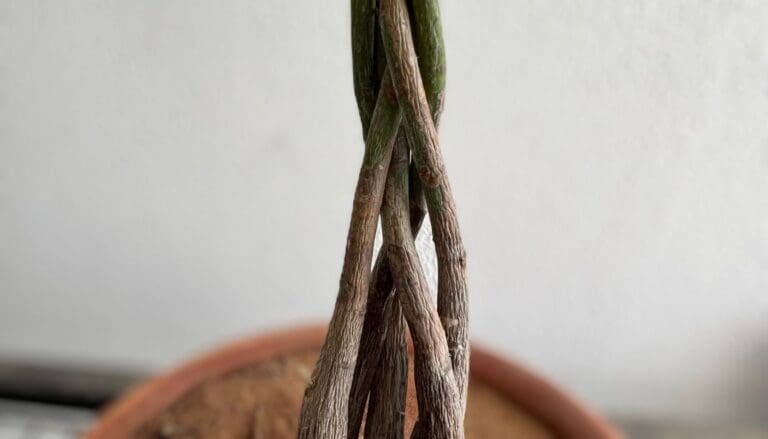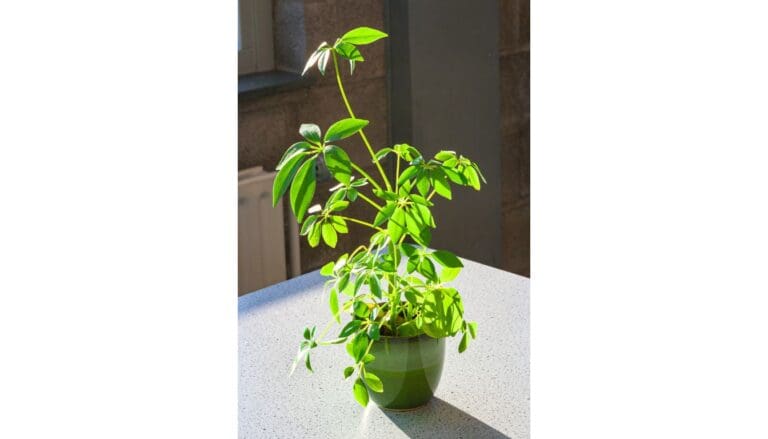How To Prune A Peace Lily? (When+Steps-By-Step Guide)
Peace lilies are great house plants. These plants have long dark green leaves and are recognized for their prominent white bracts. But do these plants and their flowers require pruning? Let’s understand.
The beautiful white blooms make the peace lilies unique. But a stalk that bloomed once will not bloom again, and the stalk will eventually brown and die. Therefore pruning off the wilted flowers and the stem is necessary for the plant to remain healthy.
Lack of pruning results in many problems for the plant. You should prune your peace lily when its flowers fade and wilt or if the plant has overgrown and is taking up too much space. Use professional pruning shears to prune a large peace lily plant.
To prune your peace lily, remove the outer leaves that have grown old and yellow. Then remove the deadhead of the plant by cutting off the stalks of the spent flower right at the base of the peace lily plant as they will not rebloom. However, make sure not to prune more than 25% of the foliage.
This article will take you through details of how to prune a large peace lily plant and why and when peace lilies need pruning.

Please note: Simplify Plants is reader-supported. Some links in the post are affiliate links and I get a commission from purchases made through links in the post.
Why do peace lilies need to be pruned?
Pruning in peace lily helps produce more blooms, stay in shape, and maintain their bushy green foliage. Pruning helps in preventing diseases and pests. It helps peace lily get rid of old and yellow leaves.
If your peace lily has grown too large for your liking, you must prune it to keep it in shape and control the overgrowth. A large peace lily often becomes messy and hard to manage, so pruning becomes unavoidable.
The pruning of dead flowers and leaves reduces the space that these take up. As in peace lily, if the stems have produced flowers, they will not produce blooms again.
While deadheading is usually enough to facilitate reblooming in other plants, in the case of a peace lily, deadheading the spent flowers will not help your peace lily rebloom. So deadheading along with pruning the entire stem is vital to get your peace lilies to bloom again.
Cutting back the entire stem will create room for the new stem growth, creating a fuller, leafier plant.
If you leave the old flowers, the plant will spend more energy developing the seeds, and the stems will turn brown. But, deadheading the wilted flowers help the peace lily to focus its energy on blooming again.
When to prune peace lilies?
Peace lilies require little pruning to stay healthy and strong.
Peace lilies do not produce many blooms like other flowering plants. So like other flowering plants, you don’t need to trim off the bunch of buds at the end of the growing season.
There is no right or wrong time when it comes to pruning of peace lilies.
You need to wait for the peace lily blooms to fade and wilt until you can prune them. And this usually takes a month after the first blooms.
You can prune the flowers and stems if they turn green. There is nothing to wait for the leaves to wilt. You should do deadhead pruning around late spring only when few blooms have faded and not before that.
While pruning dead blooms, you can also prune dead and brown leaves.
In the case of a large or overgrown peace lily plant, you can prune it any time and in any season as long as the plant is doing well. You can prune the excess growth and remove the damaged parts to keep the peace lily healthy.
Should I prune the yellow leaves and brown tips of my peace lily?

Usually, peace lilies have dark green and oval-shaped leaves. But sometimes, the leaves of peace lilies may turn yellow, or the whole branch turns yellow.
Yellow leaves or brown tips on leaves are indicators that tell us that the leaves are either damaged, dead or diseased. Yellowing mainly happens due to inappropriate watering. Its means that your lily is getting either too much or too little water.
A mineral build-up is another reason for your plants to turn yellow. This happens when you use regular tap water on your peace lily. If calcium is present in this water, the accumulation of calcium makes the roots suffocate and causes yellow leaves.
So the yellow leaves or brown tips are of no use and can even damage other leaves if they have infections or fungal diseases. So it is always better to cut back the yellow or brown tips.
Cutting down the brown tips will save the leaves from turning brown completely.
Should I prune the roots of a peace lily?

We are not supposed to trim off the roots of peace lilies. We mostly cut the roots of the plant to fit them in the pot during propagation.
But if you notice that your lily is dying without any specific reason, it can indicate that the roots are suffering from disease or are rotting.
At those times, it becomes necessary to prune the roots and cut back the infected parts. You may find that the roots become brown, smelly, and mushy.
Therefore it becomes vital to cut back the roots of peace lilies to save the plant.
What tools should you use before pruning?
Pruning a houseplant like peace lily is not a difficult task. Generally, many gardeners choose kitchen scissors for pruning peace lilies. But it’s not preferable to use these scissors as they can transmit bacteria to plants and do not have sharp edges.
So it’s better to use sharp hand pruning shears instead. They are small and scissor-like tools.
How to prune a large peace lily?
We will now discuss the process of pruning a peace lily. There are five steps involved in pruning a peace lily. They are:
- Inspect the plant
- Disinfect the pruning instruments
- Remove the damaged leaves
- Deadheading
- Ensure cleanliness after pruning
Let’s discuss these points briefly.
Inspect the plant.
Before beginning the pruning process, you must take a step back from the plant and check the extent of damage in them.
Observe whether your plant has damaged leaves or dead flowers or whether they are droopy or not. Check the bottom of the plant where the older leaves are present.
Disinfect the pruning instruments.
Before starting the pruning process in peace lily, it is necessary to disinfect the instruments you are planning to use.
Clean and disinfect pruners with soap and water solution. Pruners need to be sterilized to avoid infecting the plants with diseases.
Remove the damaged and overgrown leaves and stems.

You have to remove all the extra or damaged leaves and stems from your peace lily in this step.
You should prune the yellow leaves, shriveled leaves, diseased leaves, and the leaves with brown edges or damaged spots. These leaves make the plant looks dull and damaged. For pruning damaged leaves, make small cuts on leaves by removing the part that is damaged.
Make an angled cut below the brown tips. This angled cut will keep the leaves from turning brown. You do not need to cut back the entire leaves if the whole leaf is not damaged.
Make a clear and clean angled cut just enough to eliminate the damaged part and never cut them from the center. Cut back those damaged leaves and cut them off from that place where the leaf stalk meets the base of the stem.
Cut the stems at 45-degree angles while pruning the extra growth or to remove the damages.
Deadheading
Deadheading is a standard part of pruning if you have a flowering plant. In deadheading, we prune the dead flowers to make room for the new ones. The first step to the deadheading of peace lily is the identification of their spent blooms.
When deadheading a peace lily, focus on cutting away the bud present in spent flowers as these buds will become seeds later, and there will be no blooms.
This process should be done before the first set of healthy leaves. You can pinch or shear back all the brown flowers at the top of the stem, below the flower’s base.
You have to repeat this step on all the spent blooms of your plant. Check for the buds that may be hidden inside the foliage of the plant.
Peace lily will produce one bract in each stem, so you need to remove the wilted flowers along with the entire stem as the stem will eventually turn brown later. Prune stems off as close to the base of the plant.
This method eliminates the brown foliage and the spent flowers, and it gives the plant an overall neat look. Cutting back the entire stem gives more space, encourages new growth from the plant’s base.
Ensure cleanliness after pruning
After you prune your peace lily, it’s time for cleaning. Dispose of the sick or damaged pieces of leaves and flowers and other parts of the plant that you have pruned.
Put them neatly in a bag and trash them in the garbage. Do not leave any part behind. Peace lilies can be toxic to cats and dogs. So if you leave any leaf, stem, or flower behind, it will not be safe for the pets if they consume it.
Disinfect your shears with an alcohol solution or soap or water solution after pruning. This will eliminate the spread of diseases that could be the reason for the yellow leaves of your plant.
However, if you prune healthy stems, you can propagate to get new peace lily plants out of them.
How to care for peace lily after pruning?

Pruning can stress your peace lily, so you must care for your plant properly so that it can recover and be healthy again.
There are some care tips for your adorable peace lily plant.
Water: Peace lilies will need regular watering as they prefer moist and damp soil. Maintain a proper watering schedule for your plant and do not keep them dry.
Light: Keep your potted peace lily in a location that supports moderate indirect sunlight as they are sensitive to direct sunlight and can suffer from sunburn.
Temperature: Peace lily is susceptible to cold, so never place it in a location where the temperature is below 45°F.
Soil: Peace lily prefers rich, loose potting soil that has plenty of organic matter. Keep your peace lily soil moist but avoid overwatering as the plant is more tolerant of dry conditions than wet.
Fertilization: Peace lily requires little fertilization. It would be beneficial to use a 20:20:20 fertilizer once every six weeks.
Repotting: You should repot your peace lily whenever it gets rootbound. Repot it in a container that is one size larger with a new soil mix. Prune all the damaged and dead parts of the plant before repotting.
Final words
Prune your peace lily if the flower fades and wilt or if the plant has overgrown and takes up too much space. Deadheading of blooms and pruning the entire stem of the flower is essential to get your peace lily to bloom again.
Cut back the yellow, brown, wilted, and diseased leaves while pruning.
Use professional pruners for pruning peace lily.
Peace lilies are toxic to pets, so never leave any pruned parts of plants behind and ensure proper cleanliness after pruning. Provide your peace lily proper light, temperature, water, soil mix, fertilization, and timely pruning for their healthy growth.
Also read: How Do You Save A Dying Peace Lily? (Identifying Problems+Solutions)
Ref: ScienceDirect, NCBI, University of Vermont, Nationalgeographic, NC state university, University of Florida, The University of Arkansas, Queensland Government.
Recommended Garden Supplies
| Product Image | Our Recommended Gardening Supplies | Check Offers! |
|---|---|---|
Top Top
Top
Top
Top
Top
Top
Top
Top | rePotme Houseplant and Tropical Classic Potting Soil Mix | Check Offer On Amazon |
 Top
Top
Top
Top
Top
Top
Top
Top | Espoma Organic Indoor Plant Food | Check Offer On Amazon |
 Top
Top
Top
Top
Top
Top
Top
Top | GooingTop LED Grow Light 6000K Full Spectrum Clip Plant Growing Lamp | Check Offer On Amazon |
 Top
Top
Top
Top
Top
Top
Top
Top | Soil Moisture Meter | Check Offer On Amazon |
 Top
Top
Top
Top
Top
Top
Top
Top | Govee Hygrometer Thermometer, Bluetooth Enabled! | Check Offer On Amazon |
 Top
Top | LEVOIT Humidifiers for Large Room(Best For Plants) | Check Offer On Amazon |
 Top
Top
Top
Top
Top
Top
Top
Top | Upgraded DIY Automatic Drip Irrigation Kit, 15 Potted Houseplants Support | Check Offer On Amazon |
 Top
Top
Top
Top
Top
Top
Top
Top | Stainless Steel Heavy Duty Gardening Tool Set | Check Offer On Amazon |
 Top
Top
Top
Top
Top
Top
Top
Top | Bonide Insecticidal Soap | Check Offer On Amazon |
 Top
Top
Top
Top
Top
Top
Top
Top | Bonide 32 oz Spray Neem Oil for Organic Gardening | Check Offer On Amazon |
 Top
Top
Top
Top
Top
Top
Top
Top | Garden Safe Fungicide | Check Offer On Amazon |






